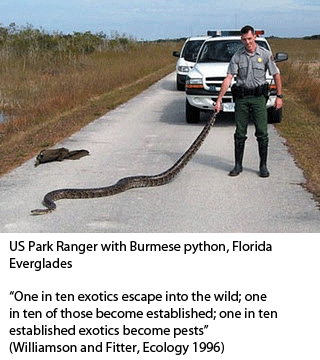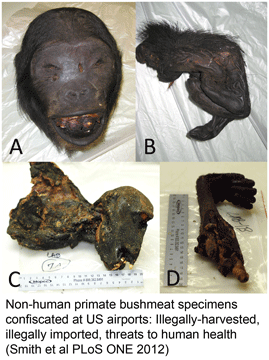 Zoonotic viruses are like introduced species–most perish, a few cause localized outbreaks, and a tiny fraction spread widely. Unfortunately, the tiny fraction have ruinous potential.
Zoonotic viruses are like introduced species–most perish, a few cause localized outbreaks, and a tiny fraction spread widely. Unfortunately, the tiny fraction have ruinous potential.
Human immunodeficiency virus (HIV), a retrovirus that jumped from chimpanzees to humans less than 100 years ago, now infects about 34 million people, with over 30 million deaths so far. Human T-cell lymphotropic virus (HTLV-I) another introduced non-human primate retrovirus, is endemic in many human populations around the world, and may result in a so far untreatable, slowly-progressing ascending paralysis.
In 2009, a previously unknown coronavirus (related to human cold viruses) from masked palm civets caused a global epidemic of SARS. A diversity of other viruses from a diversity of animal hosts have demonstrated ability to cause high mortality outbreaks with person-to-person transmission including Nipah virus (fruit bat paramyxovirus), Ebola virus (primate filovirus), lassa virus (mouse arenavirus), and rabies (rhabdovirus with primary reservoir in bats).
What else is out there? An untold diversity of vertebrate viruses, some fraction of which have the potential to cause human epidemics, perhaps particularly those from primates and bats. It makes sense to keep an eye on viruses in animals and products derived from animals and to limit human exposure to known or potential pathogens.
 In January 2011 PLoS ONE 19 researchers from seven institutions including US Centers for Disease Control report on exotic viruses in bushmeat (meat of African wild animals) seized at five US ports of entry. In this pilot study, Smith and colleagues analyzed tissues derived from parts of 44 individual animals, mostly non-human primates, found in 26 passenger-carried or postal shipments intercepted between 2008 and 2010, plus additional tissues from body parts of 16 non-human primates seized by US Fish and Wildlife Service in 2006, which were part of a successful federal smuggling prosecution. For confiscated specimens lacking external morphological features, species identity was determined by COI barcode and/or other mitochondrial genes. As an aside, I note that the phrase “DNA barcode” is in the methods section references but does not appear in the text. I view this as a kind of progress, a reflection of how barcoding is now a usual way to confirm species identity. When a method is fully established, it recedes into the background. For example, in medicine we say “the white blood cell count is 10.7,” not “the white blood cell count as determined by Coulter counter is 10.7.”
In January 2011 PLoS ONE 19 researchers from seven institutions including US Centers for Disease Control report on exotic viruses in bushmeat (meat of African wild animals) seized at five US ports of entry. In this pilot study, Smith and colleagues analyzed tissues derived from parts of 44 individual animals, mostly non-human primates, found in 26 passenger-carried or postal shipments intercepted between 2008 and 2010, plus additional tissues from body parts of 16 non-human primates seized by US Fish and Wildlife Service in 2006, which were part of a successful federal smuggling prosecution. For confiscated specimens lacking external morphological features, species identity was determined by COI barcode and/or other mitochondrial genes. As an aside, I note that the phrase “DNA barcode” is in the methods section references but does not appear in the text. I view this as a kind of progress, a reflection of how barcoding is now a usual way to confirm species identity. When a method is fully established, it recedes into the background. For example, in medicine we say “the white blood cell count is 10.7,” not “the white blood cell count as determined by Coulter counter is 10.7.”
The seized bushmeat included 25 individual animals representing five non-human primate species [2 chimpanzees (Pan troglodytes ellioti; IUCN Red List endangered), 2 mangabeys (Cercocebus atys; IUCN vulnerable), 10 baboons (Papio papio; IUCN near threatened), 5 guenons (Cercopithecus nictitans), 6 African green monkeys (Chlorocebus sabaeus)], and 35 rodents from at least two species [32 confirmed or suspected cane rats (Thryonomys sp.), and 3 unknown rat species]. It is unclear from the article how many of the specimens were barcoded to determine species identity.
Samples were screened by PCR for multiple bacterial and viral pathogens. Pathogenic viruses were found in tissues from all 5 non-human primate species, including strains of cytomegalovirus and lymphocryptovirus (both herpesviruses) and 4 strains (3 of which were novel) of simian foamy virus (a retrovirus). So we have many things wrong–endangered species, illegally harvested and imported, carrying potential threats to human health. How big is the problem? According to the authors, although “the amount and characteristics of bushmeat reaching US borders is not well described…[one] study estimated that 273 tons of bushmeat was imported every year into Paris…on Air France carriers alone” (Chaber et al 2010 Conserv Lett). The threats to endangered species and human health from bushmeat trade are one part of the enormous traffic in wildlife (120 million live animals and 25 million kilograms of non-live wildlife are imported annually into US) (Pavlin 2009 Emerging Infect Dis). The authors conclude with a call for “broader surveillance efforts and pathogen identification and discovery techniques in wildlife and wildlife products…to further mitigate potential risks.” Let’s hope they do so.